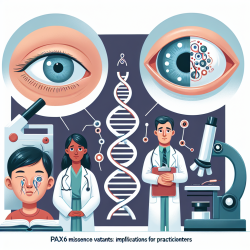Introduction
In the realm of speech language pathology and therapy, understanding the multifaceted influences on adolescent behavior is crucial. A recent study titled "HIV-related sexual decisions made by African-American adolescents living in different family structures: study from an ecodevelopmental perspective" offers valuable insights into how family dynamics and social environments impact adolescent decision-making, particularly in relation to sexual health. This blog explores how practitioners can integrate these findings into their therapeutic practices to foster better outcomes for children.
The Ecodevelopmental Framework
The ecodevelopmental theory, as utilized in the study, provides a comprehensive model for understanding the complex interactions between adolescents and their environments. This theory highlights the importance of family function and social contexts, emphasizing four domains: microsystem, mesosystem, exosystem, and macrosystem. Each domain plays a critical role in shaping adolescent behavior and decision-making.
Key Findings and Implications
The study examined the sexual decision-making of African-American adolescents across different family structures. Key findings include:
- Emotional Connection: Adolescents living in two-parent households who felt more love from their parents tended to delay sexual initiation.
- School-Level Factors: For those in single-parent households, school-level influences were significant in delaying sexual initiation.
- Immediate Social Contexts: Adolescents living with other relatives or alone were influenced by their living environment, such as neighborhood safety and housing conditions.
These findings suggest that the family structure significantly modifies the associations between parenting functions, social contexts, and adolescents' sexual decisions.
Practical Applications for Practitioners
Therapists and educators can leverage these insights to enhance their interventions. Here are some practical applications:
- Family Engagement: Encourage stronger emotional connections between adolescents and their parents, especially in two-parent households, to foster protective behaviors.
- School Collaboration: Work closely with schools to enhance supportive environments for adolescents in single-parent homes, utilizing school-level factors as a protective mechanism.
- Community Involvement: For adolescents living with other relatives or alone, community-based interventions focusing on improving neighborhood safety and housing conditions can be beneficial.
Encouraging Further Research
While the study provides a robust framework, it also highlights the need for further research into the dynamics of family structures and their impact on adolescent behavior. Practitioners are encouraged to explore these areas further to develop more targeted and effective interventions.
Conclusion
By integrating the ecodevelopmental perspective into therapeutic practices, practitioners can better address the diverse needs of adolescents. Understanding the role of family structure and social contexts in shaping behavior is essential for creating data-driven, effective interventions that promote healthier outcomes for children.
To read the original research paper, please follow this link: HIV-related sexual decisions made by African-American adolescents living in different family structures: study from an ecodevelopmental perspective.










